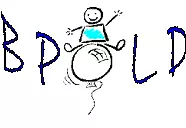|
Clinical details:
Definition
Bronchiectasis is a pathological term used to describe abnormal persistent dilatation of the bronchi and bronchioles. Bronchiectasis (of non-cystic fibrosis origin) in childhood is a relatively uncommon suppurative lung disease.
Clinical Presentations
Bronchiectasis can present in either of two forms - a local or focal obstructive process of a lobe or segment of a lung, or a diffuse process involving both lungs and often accompanied by other conditions, such as sinusitis and asthma.
Children usually present with recurrent chest infections, respiratory symptoms such as chronic cough and sputum production. Some children may present with wheeze and shortness of breath. These symptoms are usually related to retained secretions and frequent chest infections resulting in obstruction and damage of the airways.
On clinical examination finger clubbing may be present and persistent crackles with or without wheeze may be heard on auscultation.
Causes
By definition, causes of bronchiectasis of unknown cause are unknown, however it is important that causes are ruled out by careful history (foreign body, pertussis/other infant infection) and other potential conditions also sought (see investigation below). It is particularly important to understand that bronchiectasis can present some time before serological testing of immune function (immunoglobulin levels) decline and repeat testing in patients with bronchiectasis of unknown cause is warranted.
Diagnosis and Investigations
Stepwise approach to investigation:
A baseline chest X-ray should be done in all patients but mild cases of bronchiectasis may not be evident. High resolution computed tomography (HRCT) scan of the lungs is generally accepted as the gold standard to establish the diagnosis of bronchiectasis and should be performed in all patients when there is a clinical suspicion.
Once the diagnosis of bronchiectasis is confirmed on HRCT, further investigations should be performed to establish cause and severity of disease. These tests are not indicated in all patients and a step-wise prioritisation of investigations is suggested depending on the clinical features of the individual patient.
- Lung function (spirometry) should be assessed in all children old enough (usually age 5 years and above) to perform the tests
- Sputum or cough swabs for microbiology
- Serum immunoglobulins to screen for immunodeficiency
- Sweat test to screen for cystic fibrosis
- Gastro-intestinal investigations such as 24-hour pH study and upper gastro-intestinal barium studies to rule out gastro-oesophageal reflux, and video fluoroscopy to rule out aspiration
- Nasal nitric oxide as a screening test and ciliary investigations to rule out primary ciliary dyskinesia particularly in those patients who present with associated symptoms of rhinitis and sinusitis
- Flexible bronchoscopy when a single lobe is affected, and in some patients with frequent infections where a pathogen is not identified
Studies report an unidentified cause in 25-48% of all children with bronchiectasis (Edwards et al, Li et al, Bastardo et al).
Course
Bronchiectasis in children and young people is of variable course: resolution can occur in some over time. The majority however continues to have airway damage and limitation of collateral damage is a mainstay of paediatric treatment strategies.
-
Evidence Gap: The natural history of children with bronchiectasis of unknown cause is poorly documented.
Treatment
The foundation of therapy in bronchiectasis has been largely empirical based on therapeutic strategies in cystic fibrosis bronchiectasis. As with any chronic respiratory disease of childhood the goal of treatment is to prevent disease progression, reduce infective exacerbations and maintain or improve pulmonary function. This is achieved by identification and treatment of underlying conditions, early treatment of acute infective exacerbations with antibiotics, prophylactic antibiotics to suppress microbial load, airway clearance therapies and immunization. In localised bronchiectasis not responding to medical treatment, occasionally surgical removal of damaged segments or lobes is indicated to avoid ‘spill-over’ infection of other lobes of the lung.
-
Evidence Gap: There is a significant paucity of research for interventions in bronchiectasis affecting children and young people. In particular there is lack of evidence for: What is the effect of -
- Regular or intermittent (exacerbation) chest physiotherapy
- Chest physiotherapy during an exacerbation (recent benefit demonstrated for adults with bronchiectasis)
- Antibiotic (azithromycin) prophylaxis
- Regular versus intermittent intravenous antibiotics
- Mucolytics (DNase/Hypertonic saline)
- Nebulised antibiotics for chronic infection
|
|
Useful references:
Bronchiectasis.
|
Barker AF.
|
Engl J Med 2002; 346:1383-93
|
Retrospective review of children presenting with non cystic fibrosis bronchiectasis: HRCT features and clinical relationships
|
Edwards EA, Metcalfe R, Milne DG et al.
|
Pediatr Pulmonol 2003; 36:87-93.
|
Non-CF bronchiectasis: does knowing the aetiology lead to changes in management?
|
Li AM, Sonnappa S, Lex C et al.
|
Eur Respir J 2005; 26:8-14
|
Non-cystic fibrosis bronchiectasis in childhood: longitudinal growth and lung function
|
Bastardo CM, Sonnappa S, Stanojevic S et al.
|
2009; 64:246-51
|
Web links:
http://www.lunguk.org/you-and-your-lungs/conditions-and-diseases/bronchiectasis.htm
http://www.patient.co.uk/health/Bronchiectasis.htm
http://www.nhs.uk/conditions/Bronchiectasis/Pages/Introduction.aspx
http://www.nhlbi.nih.gov/health/dci/Diseases/brn/brn_whatis.html
Download this text as a .PDF HERE
|

